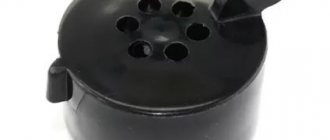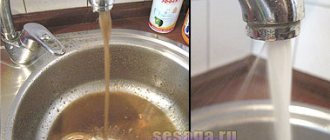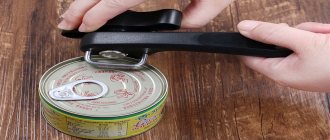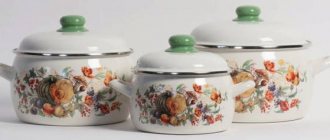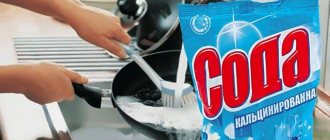Shiny coins in numismatists’ collections are the result of using Asidol. The cleaning fluid is used by jewelers. The environment contains carbon dioxide and ammonia, which requires the use of personal protective equipment during work. Has a pungent odor. Not suitable for aluminum and painted metal objects; It’s also better not to take risks with antique coins, as scratches will remain due to the abrasive particles they contain. Price 150 rub.
If you are faced with the painstaking task of cleaning metal products, and available folk remedies are powerless, “Asidol” will come to the rescue. Years of use have confirmed high quality and effectiveness. It has its own price, and use does not require special knowledge or skills.
Properties, functions
Mainly used to restore copper and nickel, but aluminum and its alloys are absolutely not suitable for painted metal objects. Produced in Russia.
Used for cleaning metal.
Asidol is a white oily liquid with a characteristic pungent odor. It is obtained by treating oily waste (petroleum, kerosene, solar energy) with sulfuric acid. When working with the substance, the smell quickly evaporates, filling the entire room, which is due to the presence of active additives. Also includes:
- carbonic acid;
- ammonia;
- sodium salts of naphthenic acids;
- surfactants;
- wax (synthetic origin);
- abrasive materials;
- mineral oils.
There are several markings on the product. Each number indicates the intended use of the product. “Acidol number 4 is used when you need to fix a scratch on metal and add a matte finish (this type is ideal for cleaning fireplace grates). Thinner metal parts are treated with substance No. 3. Marks 1 or 2 are suitable for shine.
Time-tested traditions
In people’s associations, the concepts “GOI paste”, “mirror shine” and “army plaque” are located side by side. It’s not surprising, since it was invented in the 30s. of the last century, the composition helps to shine the shine on the belt plaques of generations of defenders of the Fatherland.
This paste (not Goya, in honor of the Spanish artist Francisco Goya, but GOI, named after the State Optical Institute, where the technology for preparing a preparation originally intended for polishing lenses was developed) will please you with its price. The cost varies from 300 to 500 rubles per kilogram, and a small jar can be purchased at Leroy Merlin or Voentorg for 50 rubles.
There are four different options in which GOI paste is presented. The application depends on the tasks facing us. Paste No. 4 will be useful in cases where you need to rub out scratches on the material, giving the surface a matte tint. The paste is convenient to use, for example, when you need to thoroughly clean fireplace grates . Paste No. 3 gives a finer surface treatment. However, if you are interested in a truly mirror-like shine, you will opt for No. 2 or 1.
Where is it used?
Numismatists working with bimetallic copper-nickel coins most often need “Asidol”. The drug effectively removes dirt, plate grease, oxidation, and sometimes a layer of corrosion. Because abrasive varnish particles leave microscopic scratches that are invisible to the eye but visible under a magnifying glass, the value of antique and precious coins may decrease. Therefore, for rare cases of cleaning hazardous liquids.
Jewelers use this cleaner to clean items made from precious metals.
They know how to use Asidol soldiers. Since the days of the Soviet army, the military cleaned brass buttons, buckles, and rubbed the belt buckle to make it shine. The ideal result was considered the moment when the soldier saw his reflection on the board on the military belt.
Tips for using household cleaning fluid:
- cleaning silver (dishes, cutlery, figurines, etc.);
- polishing of non-ferrous metals, stainless steel elements;
- cleaning chrome and nickel surfaces;
- removal of impurities from steel, copper structures, internal elements.
“Asidol” is used to process any metal except painted and aluminum.
Features of application
Since the composition contains ammonia, you should take care of your personal safety by wearing rubber gloves. Algorithm for cleaning metal products:
- Wipe the impregnated surface dry (the abrasive stops working when it comes into contact with moisture).
- Shake the bottle and spray the liquid onto a metal object.
- Leave for 1-3 minutes depending on the intensity of the contamination.
- Wipe with a cloth or short-bristled brush.
- Rinse the substance off with water.
One treatment is enough to remove the oxide layer from the surface of the coins.
To achieve a high-quality result, you need to know how to use Asidol.
To clear a soldier's plate, other similar items work as follows:
- Make sure the object is not scratched.
- If there are any, sand them before processing, otherwise the paste will get into the grooves, turning the board greenish.
- Apply a small amount of Asidol to felt cloth and wipe the metal.
- A reflection visible on the board will indicate the end of the procedure.
After cleaning, any remaining products should be disposed of as usual. The pollution disappeared without a trace. The result is a clean, shiny metal.
How to clean metal products?
The use of any chemical substance, including Asidol-M, requires compliance with safety regulations. The product should be used in a well-ventilated area so that the person does not feel sick from the strong odor. Before work, wear rubber gloves to prevent irritation from the chemical composition on the skin of your hands. Only when following precautionary measures do they begin to clean the products:
- Before starting work, you should prepare everything you need: several dry, clean pieces of soft cloth, rubber gloves, a sponge, a microfiber cloth.
- The surface of the metal item to be treated is wiped with a cloth until the item is completely dry. In the presence of humidity, the abrasives contained in Asidol-M will not work. After this, it is not recommended to use the fabric again.
- The product is placed on a flat horizontal surface.
- Shake the bottle with the product vigorously and then open the lid.
- The product is applied to the entire surface of the product using a small sponge.
- After waiting 1-2 minutes, clean the item with a soft toothbrush.
- The product is wiped with another piece of cloth.
- The remaining product is washed off the item under running cool water. If necessary, clean off the product with a toothbrush.
- The product is repeatedly wiped with a cloth and polished with a microfiber cloth.
- If it is not possible to remove all contaminants at one time, then repeat the cleaning procedure.
Despite the fact that Asidol-M is sold only in specialized stores, the substance is popular among ordinary users. The miraculous properties of the product allow you to quickly get rid of dirt on different surfaces. In addition to numismatists, the product is used by people working in dirty industries and collectors of metal objects.
Advantages, disadvantages, price
The product "Asidol" began to be produced at the beginning of the last century, so today it is on the lips of many people. After replacing brass buttons on military uniforms with plastic ones, the liquid did not become so popular. But it still applies, highlighting a number of the product's strengths:
- availability;
- economical consumption;
- easy application;
- quality result;
- Suitable for common and precious metals;
- cleaner + polish in one bottle.
But this liquid has some negative qualities:
- Strong smell;
- aggressive effects on the skin (people sensitive to aggressive odors are recommended to additionally protect their respiratory tract with a mask);
- aluminum is not suitable for cleaning painted metal surfaces;
- Due to abrasive particles in the composition of the product, micro-scratches remain on the metal.
“Asidol” is sold in metal stores, but today it can not be found on the shelves as often as before. Those who find a bottle with a miracle cleanser are doubly happy - the price is also lucky (600 ml capacity 300 rubles and 120 ml - 150 rubles).
Polishing plexiglass with your own hands: affordable methods
How to polish plexiglass? Can this be done without contacting specialists? What do you need to purchase in advance to carry out the process as quickly and without any problems? What problems does polishing solve? The answers to these and other questions are in this article.
Organic glass (sometimes called plexiglass) is a polymer material that is particularly durable and hard. Transparency is 2.5 times higher than that of ordinary glass. Light rays are not distorted as they pass through. The material itself produces virtually no haze.
An additional important advantage is resistance to mechanical shock. Thanks to it, plexiglass is widely used for the manufacture of display cases, office partitions, doors, car windows, portholes, microscopes, aquariums, etc. But with all the undoubted advantages of the material, it is not without some disadvantages.
Small cuts and cracks appear on its surface due to contact with foreign objects and substances. If you really want to, you can scratch it. The presentable appearance is lost, the performance and consumer qualities of the product deteriorate. Polishing the plexiglass will help restore them.
The work is painstaking and requires a certain perseverance and perseverance, but the result is worth it.
The main condition is that chemically active, aggressive preparations containing large volumes of abrasive substances should not be used.
This is the answer to the question for those who are interested in whether it is possible to polish plexiglass with Asidol? Theoretically, everything is possible. In practice, the surface will become cloudy, dull, and new cracks and scratches will appear on it.
Asidol is designed specifically for polishing metal, jewelry and antiques, including nickel and copper.
If the label says “Asidol M”, the composition contains ammonia. And this component has a destructive effect on the structure of organic glass. The surface will not be transparent and shiny, but “dirty.”
What you need for work
The easiest and fastest way to polish plexiglass is on special production equipment: special machines with metal discs and polishing pastes.
Final sanding is carried out using felt and/or cloth materials. No less popular is the chemical method of returning the original appearance using a mixture of hydrofluoric and sulfuric acids.
The result is absolutely smooth surfaces, without cracks or cuts.
But polishing plexiglass can be done at home. All you need to do is purchase the materials listed below and have a little patience. You will need:
- masking (paper) tape. It is used to cover edges and areas that cannot be polished;
- paper;
- polishing paste;
- sandpaper. First, No. 800 for rough processing, then No. 2000 for fine grinding;
- construction or regular knife. Alternatively, use a medical scalpel.
How does polishing work?
Polishing plexiglass with your own hands involves performing the following steps:
- glass is removed from the product. If this is not possible, cover all surrounding surfaces with masking tape. If the glass is removed, it is enough to paste over only the ends. At the end of the work, the adhesive from the tape is thoroughly wiped off;
- rough polishing using #800 sandpaper. You need to add water to make the process easier.
How to polish plexiglass with your own hands? There's no hurry. Movements should be as smooth and uniform as possible. When finished, the surfaces are wiped clean. After the first stage, the glass becomes completely opaque. The main thing is a completely uniform color. If this is not the case, the polishing procedure continues.
The next steps are:
- To polish plexiglass by hand, use sandpaper No. 2000. The process continues until the glass becomes transparent. There should be no scratches or cracks on the surface, even after careful inspection. If defects are found, the grinding process is repeated again. If necessary, skins No. 800 and 2000 are used alternately;
- the next step will require plexiglass polishing paste. It is applied to the surface. The work continues, but not with sandpaper, but with a soft cloth. At the end of the process, the glass should become shiny.
Next, it remains to inspect the surfaces again. Any defects found? The above process is repeated again. Everything is fine? Are the results completely satisfactory? You can remove the tape from the edges and get rid of the glue. Are there any jagged edges? They are polished in the same way as described in this paragraph.
The video below the article will tell you in detail how to polish plexiglass at home.
How to polish plexiglass until transparent with GOI paste
The previously described method is not the only way to polish to complete transparency. If you have GOI paste, you can use it and felt to tidy up the surfaces. No felt? A shoe insole, a piece of felt felt, or a cotton pad will do.
Polishing plexiglass at home involves applying a small amount to the surface and then processing until transparent. If the glass is old, you will additionally need fine-grain sandpaper. The surface is periodically wetted with water during the treatment process.
A few more ways to clean glass
Do you have experience working with fire? Plexiglas can be fired. At the first stage, you will need zero skin. Then the firing itself is carried out. The main thing is to achieve maximum uniformity so that there are no burned areas.
How to polish plexiglass from scratches? You can use car polish. The composition is applied to the glass. And the already familiar felt or cotton pads come into play. Are you afraid that the surface will be damaged? You can experiment on a small area. The process is completed by rubbing with a small amount of sunflower (any vegetable) or machine oil.
How to replace GOI paste
How to polish plexiglass from scratches? GOI paste is one of the most popular materials for polishing. But it also has certain disadvantages that need and are important to remember.
In particular, the composition includes a certain amount of chromium oxide. It penetrates even into tiny crevices. It will not be possible to remove it in the future even with a strong desire.
It will not be possible to achieve the intended goal even if the abrasive particles are too large. They will not polish the glass, but will only scratch it.
Anti-scratch plexiglass polish can be replaced with other products, but without ammonia. Because of this component, glass becomes faded and loses its original transparency and presentable appearance.
If you have cans of different sprays, they can be used for polishing. Hot water is mixed in equal proportions with white wine vinegar. This composition is poured into a can and then applied to the glass. An additional advantage of the method is antibacterial protection. There will be no conditions for the growth of mold on the surface.
No cans? You can get by with toothpaste or powder. Another quality alternative is powdered chalk. But without felt circles or other soft fabric, it will not be possible to complete the process properly.
The video at the bottom of the article will tell you in more detail how to polish plexiglass at home.
What to do if you need frosted plexiglass
Polished plexiglass is the main material for making not only aquariums, but also decorative display cases, stained glass windows, screens and partitions. And the listed structures do not always have to be transparent.
The matte surface is also useful for decorative, light and music design of a bar or nightclub. In this case, careful polishing with fine-grained sandpaper is not required.
It is enough to treat it with a piece of coarse grain.
How to polish plexiglass at home to make it matte? Another option is chemical matting. But it requires some experience and knowledge to avoid damage to the source material and burns.
Tips for newbies!
In the previous paragraphs of the article, we looked at how and with what to polish plexiglass at home. But it is important to remember that all of the above options involve the formation of some volumes of dust, which negatively affects a person’s lungs and his health in general. GOI paste is not the most useful drug either. If it is accidentally swallowed or inhaled, you may end up in intensive care.
How to sand plexiglass at home? Everyone chooses the method and material independently. The general point is the need to follow safety precautions. In addition to all the previously listed materials and tools, you will need a respirator or mask, gloves, goggles and large volumes of water. The surface must be constantly moistened to prevent dust from forming.
The video will show you in detail how to polish plexiglass at home:
